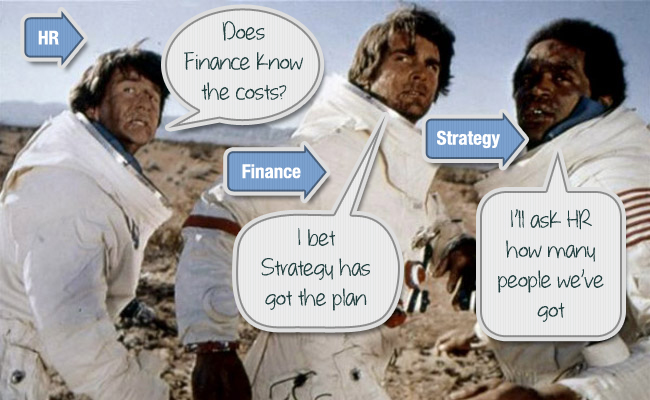How HR, Finance and Strategy need to evolve for organizational design of the future
5 key warning signs that people data is not well handled

*This is the final blog post in a series of 6. If you haven’t already, please read part 1, part 2, part 3, part 4 and part 5.
Whose roles will change as a result of the new analytical opportunities with people data? The potential for insight is an opportunity but it could also be a threat. In this section we look at what is happening now, key warning signs to look out for and the future of people analytics.
What is happening now?
Historically, people data has been the preserve of the HR Director. Yet many of the HR professionals I speak to have seen their functions shrink while Finance and IT have grown. HR transactional activities, such as payroll, recruitment, induction, training and surveying, have been automated and outsourced. The remaining HR professionals often don’t have the training or aptitude to talk analytics with the Finance and Strategy teams. So, the board of directors often looks to Finance to validate people data and carry out organizational analysis. Peter Cheese’s work at the CIPD, including a collaboration with CIMA, has been seeking to address this.
5 key warning signs that people data is not well handled:
| Warning sign | Impact | Gap type |
| If the HR team is asked to implement a new organizational structure presented to them by executives | Risk of fragmented change process not fully thought out or bought into | Organizational design |
| If the HR and the Finance team don’t use the same numbers for headcount or costs at each level | Loss of HR authority in the boardroom | Baselining |
| If the HR team can’t easily respond to Lord Davies’ questions on headcount split by gender, grade, performance and pay | HR becomes tied down with manual data collection and analysis | HR analytics |
| If the business can’t say how many FTEs are needed per role per year to serve the business plan for the next 3 years | Lack of control of headcount, cost overruns and lack of ability to track | Strategic workforce planning |
| If the business can’t analyze ‘through’ the data e.g. performance, skills or succession risks by client or process | Unprofitable or dissatisfied clients and ongoing inefficient activities in the business | Strategic HR skills |
What is the future of people analytics?
If analytical skills and the capability to take on a new systemic view are missing, it’s possible that some organizations will take people analytics away from the HR team. If so, there’s a serious risk that HR will lose the authority and capability to carry out organizational design, for whoever manages the data is in pole position to define the future. This gives reason for concern because there are risks if HR is not involved intimately in the organizational design process. First, many angles of organizational design have direct impacts on people: from changes to line manager relationships, to changes of location, changes to job descriptions, changes to availability of roles at all. So, if HR is not involved strongly, it’s likely that some key aspects will be managed badly.
Second, of course, a new organizational structure might not be needed at all. The power of the new analytics might lead people to overemphasise the virtues of restructuring and to forget that an integrated approach to organizational design, some quieter organizational development steps and a consistent emphasis on delivery will be enough to deliver the strategic aims of the organization. So, I would argue that HR shouldn’t hand over responsibility to Finance or Strategy. It has to be closely in touch with the new potential of people analytics and needs to have a structured framework for using people analytics for organizational design.
The designs of organizations will be different because of big data. We prefer goods that arrive on time, services that give us feedback and recommendations that are tuned to our needs and preferences. But the process of organizational design isn’t a big data challenge. The process of organizational design is fundamentally driven by the unusually incomplete, bundled and reflexive and the linked nature of people data. People data is multi-aspect with many-to-many links, differing fundamentally from the flat, single-aspect view of relational databases. Successful organizational design in the future will use all the traditional tools of ‘flat’ organization analysis and supplement them with the new graphing tools. At last, the organization will be treated properly as a system. Organizational design is not a big data challenge; it’s a people data challenge.